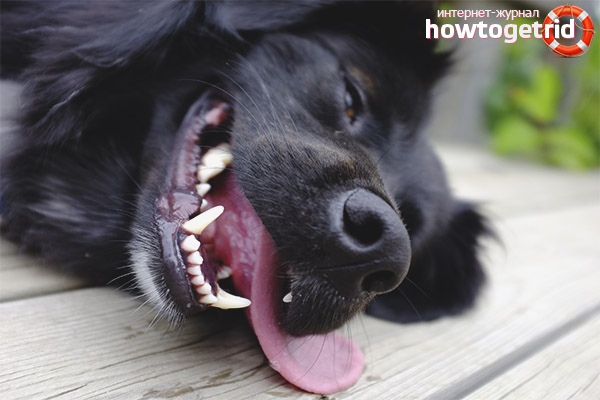The content of the article
The coat of representatives of the canine family has excellent thermal protective properties. It protects animals from hypothermia, but creates some discomfort when it is hot outside. The problem is that dogs have no tendency to sweat when overheated, like humans. Their only sweat glands are located only on the paw pads. For this reason, overheating is much more dangerous for dogs than for humans.
How is this dangerous?
Since the body temperature of dogs is regulated only by the airways, it is extremely important to ensure that they have adequate oxygen supply. If it is not enough, this leads to a sharp increase in body temperature in the pet. This condition carries a mortal danger, and therefore requires urgent action.
Characteristic symptoms of heat stroke in dogs
First of all, you need to pay attention to rapid breathing and shortness of breath - these are the things that indicate the presence of overheating of the body of the animal. If the air temperature is too high, then on sunny days you should refrain from walking at noon. With thermal shock, complications can be avoided if the necessary measures are taken.
Heat stroke in dogs is manifested as follows:
- The animal’s breathing becomes heavy and quick. The dog breathes loudly while lying on his stomach with his tongue sticking out. There is increased salivation.
- Intermittent breathing is accompanied by redness of the mucous membranes of the eyelids. The dog’s body temperature rises.
- A red mesh appears on the eyelids - this is how the bursting capillaries manifest themselves. The condition is accompanied by trembling or convulsions, the presence of involuntary bowel movements and urination is possible. The general condition has signs of poisoning.
- The mucous membranes of the mouth and eyes become bluish. Body temperature drops sharply. The animal may fall into a state of coma or lethargic sleep.
In the case when the body temperature is reduced to normal values, the animal should still be shown to the doctor for preventive purposes in order to avoid dangerous consequences that can manifest itself a few days after heat stroke.
Causes of Heat Stroke
A prolonged stay in conditions of elevated air temperature above 25 degrees can lead to thermal shock in the dog. But the most common reason is some negligence on the part of the owners.
- Enhanced physical activity of the animal.
- Lack of drinking water at high ambient temperatures.
- The inability to move for a long time in hot conditions.
- Long stay of the dog in the car with the windows closed.
Urgent measures
The first thing to do is to change the place of stay of the pet. There is no need to rush to give antipyretic drugs, the use of aspirin is especially dangerous - this can lead to other undesirable consequences.
- At home, you need to immediately cool the pet with a bath with a water temperature of not more than 40 degrees.
- With cool water from a shower sprayer, you need to water the entire body of the animal, starting from head to tail.
- The dog's head should be raised during the procedure. This will make it possible to avoid aspiration pneumonia.
- If it is not possible to provide your pet with a bath, you can use a garden hose or other available water sources.
- Applying a cold compress to the animal’s head will help reduce body temperature.
- To avoid a shock state, it is worth rubbing the dog's legs vigorously.
- Adequate water intake is mandatory. It will help to resume the content of minerals in the body by adding a small amount of salt in the drink.
When should I seek veterinary care?
Regardless of whether the animal loses consciousness or not, and how quickly recovery has occurred, you should carefully consider the following important points:
- Check for the presence of a shock condition in the doggie.
- Measure the body temperature of the animal at intervals of every 10-15 minutes. Wet paw pads with cool water until it drops below 39.4 degrees.
- In case there is a decrease in temperature to around 38 degrees, you do not need to worry. This does not pose such a danger as its increase, but requires urgent consultation of a veterinarian.
- With symptoms of a shock condition - you need to urgently seek help.
- Contact a veterinary clinic immediately. Subsequently, heat stroke may develop cerebral edema or blood clotting. It can also cause kidney failure. On the way to the veterinary clinic, you need to maximally protect the pet from additional overheating.
Symptoms of shock
Early phase
- Breathing quickens, pulse and heart rate accelerates.
- Pallor of the mucous membranes is observed.
- The dog becomes anxious and restless, can aimlessly rush about the room.
- Excessive lethargy and drowsiness.
- Lowers body temperature.
Deep phase
- Heart rhythm disturbance and intermittent breathing.
- Pale and cyanotic gums.
- Breathing becomes infrequent and shallow.
- Lack of response to stimuli from the external environment.
How to treat
Therapeutic measures include replenishing the level of fluid in the body and saturating it with the necessary minerals.
- In the most severe conditions, the fluid is administered intravenously.
- An assessment of the general condition of the animal and the study of concomitant symptoms are carried out.
- Blood pressure is measured and cardiac performance is measured using a cardiogram.
Who is at risk?
Preventative measures
Heat stroke can be avoided. Particular attention should be paid to the possibility of overheating in the hottest days of the summer period. At high temperatures, exercise and sun exposure should be limited from 11 a.m. to 5 p.m. This is especially true for long-haired individuals and those that have diseases of the upper respiratory tract. Care should be taken to breeds in which the muzzle is shortened.
When traveling long distances, you need to make sure that there is sufficient air movement in the cabin. When moving in a car, it is necessary to provide the animal with access to water. If you need to leave the car for a while, leaving your pet alone in the cabin, you need to slightly open the windows on both sides so that the dog has enough oxygen. In this case, it is desirable to leave the car in the shade, and not in the sun.
Video: dog heat stroke in summer - symptoms and treatment











Submit